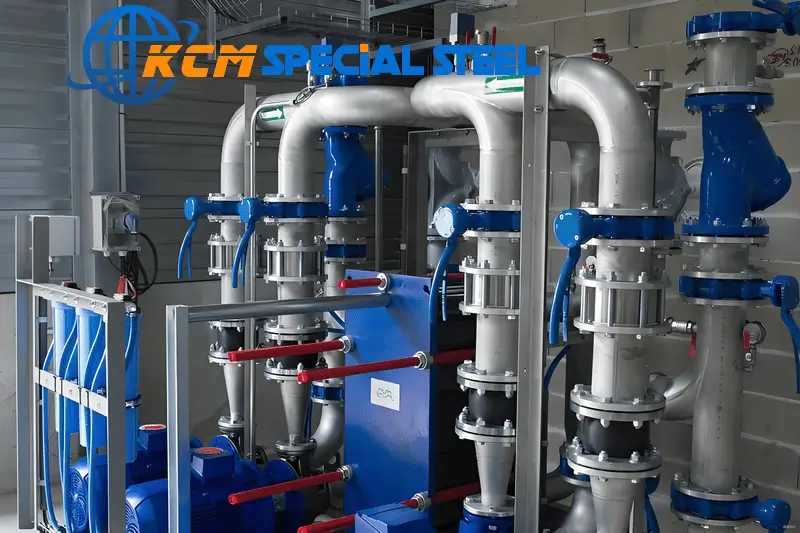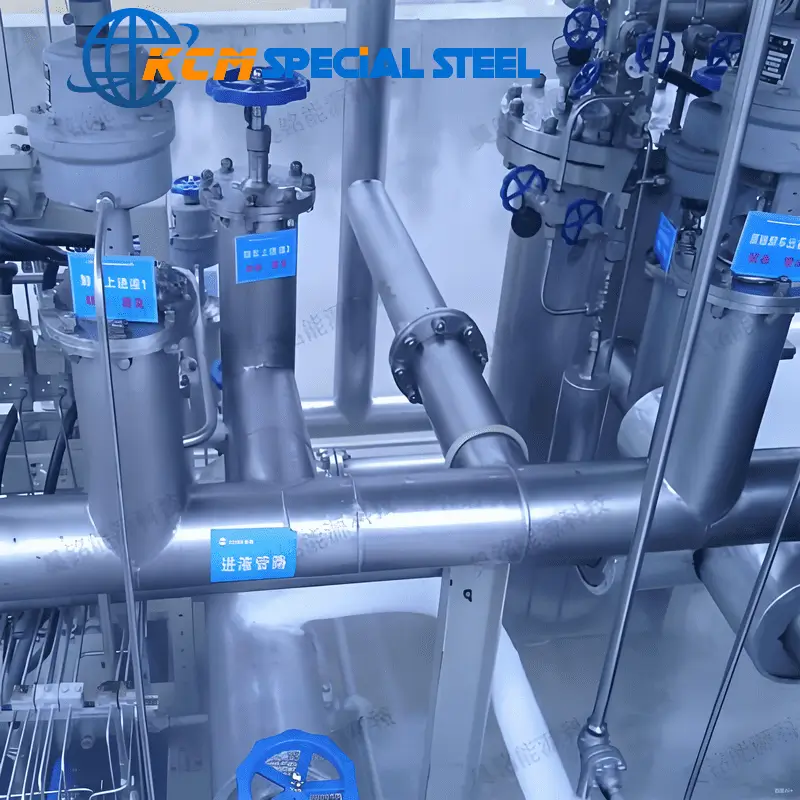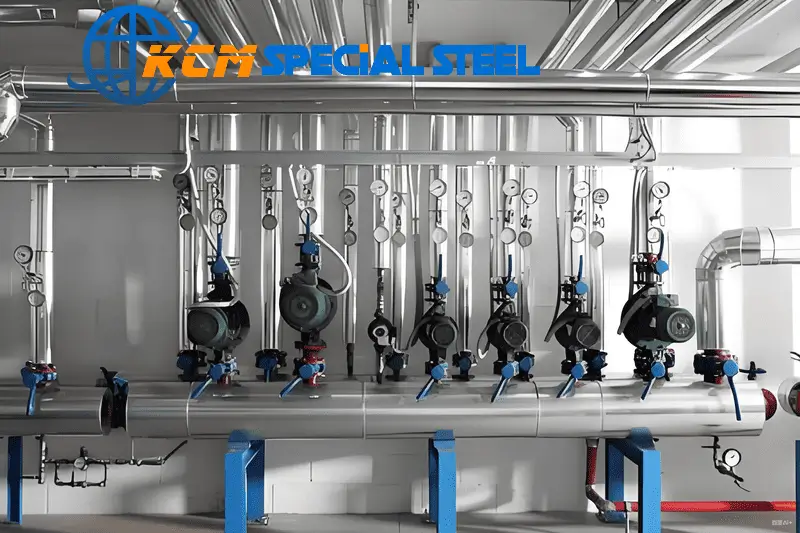1. Introduction to Pressure Calculation Formulas for Stainless Steel Pipes
Based on ASME B31.3, B36.19M & similar standards, pressure calculation formulas for stainless steel pipes seamless or welded determine the maximum internal design pressure (P), minimum required wall thickness (t), or allowable stress (S). The fundamental formula, Barlow’s modified for thin-walled pipes (D/t ≥ 6), is:
P = (2 * S * E * t) / (D – 2 * Y * t)
Where:
P: Internal Design PressureS: Allowable Stress (material/temp dependent)E: Quality Factor (joint efficiency)t: Minimum Wall Thickness (considering tolerance)D: Pipe Outside DiameterY: Wall Thickness Coefficient (material/temp dependent)
Specific formula application depends on the unknown variable (P, t, or S).
Stainless steel pipes are widely utilized in industries ranging from oil and gas to chemical processing and pharmaceutical systems due to their corrosion resistance, durability, and mechanical strength. A critical aspect of ensuring operational safety and efficiency is accurately calculating the maximum internal pressure these pipes can withstand. The pressure calculation formula for stainless steel pipes depends on parameters such as wall thickness, diameter, material grade, and temperature conditions. Notably, standards like ASME B31.3 categorize pipes into thin-walled and thick-walled types based on the diameter-to-thickness ratio (K=D/d), each with distinct calculation methodologies. This article delves into the fundamental formulas, material-specific considerations, and practical applications, providing a systematic reference for engineers and designers.
2. Fundamental Formulas for Thin-Walled and Thick-Walled Pipes
2.1 Pressure Calculation Formulas for Stainless Steel Pipes: Thin-Walled Pipe Pressure Calculation
For thin-walled pipes (K ≤ 1.2), the allowable internal pressure formula is derived from the Barlow equation and expressed as:
[ P ] = 2[ σ ] φ S / (d + S)
Where:
[ P ]: Allowable internal pressure (MPa or psi)
[ σ ]: Material allowable stress (MPa or psi), referenced from ASME Section II-D
φ: Weld joint efficiency (φ = 1 for seamless pipes)
S: Pipe wall thickness (mm or inches)
d: Pipe inner diameter (mm or inches)
This formula assumes uniform stress distribution across the wall thickness and is applicable when the diameter significantly exceeds the wall thickness. For example, in a 304 stainless steel pipe with an inner diameter of 57 mm and wall thickness of 3 mm (K = 60/57 ≈ 1.05 ≤ 1.2), the thin-wall formula applies.
2.2 Pressure Calculation Formulas for Stainless Steel Pipes: Thick-Walled Pipe Pressure Calculation
Thick-walled pipes (K > 1.2) experience non-linear stress gradients, necessitating the use of Lamé’s theory. The allowable pressure formula is:
[ P ] = [ σ ] (K² – 1) / (K⁰.⁵ · K²)
Where:
K = D/d (ratio of outer to inner diameter)
This equation accounts for higher stress concentrations near the inner surface and is critical for high-pressure applications such as hydraulic systems or steam lines.
2.3 Pressure Calculation Formulas for Stainless Steel Pipes:Key Parameter Determinations
Allowable Stress ([ σ ]): Obtained from material-specific standards (e.g., ASME B31.3) and adjusted for temperature. For instance, at 20°C, 304 stainless steel has an allowable stress of 115 MPa.
Safety Factors: Typically integrated into allowable stress values to cover uncertainties in manufacturing and loading.
Temperature Effects: Elevated temperatures reduce allowable stress; thus, corrections are essential for accurate pressure calculation formula for stainless steel pipe wall thickness.
3. 304, 316L, Duplex & Super Duplex,Nickel Alloy Material-Specific Properties and Comparisons
Stainless steel grades exhibit distinct mechanical and chemical properties, influencing their pressure-bearing capacities. The table below summarizes critical differences for common alloys:
Table 1: Comparison of Stainless Steel and Nickel Alloy Properties for Pressure Calculations
Material Grade | Typical Allowable Stress at 20°C (MPa) | Corrosion Resistance | Key Applications | Density (g/cm³) |
|---|---|---|---|---|
115 | Moderate | Food processing, general plumbing | 7.9 | |
125 | High (acidic environments) | Marine, chemical reactors | 8.0 | |
170 | Excellent (chloride resistance) | Offshore pipelines, desalination | 7.8 | |
190 | Superior (stress corrosion cracking) | High-pressure oil/gas | 7.85 | |
Nickel Alloy Inconel 625 | 210 | Exceptional (extreme temperatures) | Aerospace, nuclear | 8.2–8.9 |
Notes:
304 vs. 316L: 316L contains molybdenum, enhancing its pitting resistance and making it suitable for aggressive media.
Duplex & Super Duplex: These alloys combine austenitic and ferritic structures, offering higher strength and corrosion resistance, which allows for thinner walls and cost savings.
Nickel Alloys (e.g., Inconel): Excel in high-temperature stability and oxidation resistance, often used in superheaters or reactors exceeding 500°C.

4. Practical Calculation Example: 304 Stainless Steel Pipe
Pressure Calculation Formulas for Stainless Steel Pipes
Consider a seamless 304 stainless steel pipe with an inner diameter (d) of 57 mm and wall thickness (S) of 3 mm. Assuming ambient temperature (20°C) and no corrosion allowance:
Check K Ratio: Outer diameter D = d + 2S = 63 mm → K = 63/57 ≈ 1.105 (thin-walled).
Determine [ σ ]: From ASME B31.3, [ σ ] = 115 MPa.
Calculate Pressure:
[ P ] = 2 × 115 × 1 × 3 / (57 + 3) = 690 / 60 = 11.5 MPa.
Thus, the maximum allowable pressure is approximately 11.5 MPa (1,670 psi). Factors like safety margins or cyclic loading may further reduce this value.

5. Advanced Considerations for Stainless Steel Pipe Pressure Calculator
Pressure Calculation Formulas for Stainless Steel Pipes
Modern engineering often relies on digital tools such as a stainless steel pipe pressure calculator to streamline computations. These tools incorporate:
Automated K-ratio checks to select the appropriate formula.
Temperature-dependent stress libraries for accuracy across operating conditions.
Corrosion and erosion allowances to adjust wall thickness over the design life.
Furthermore, standards like EN 13480 and ASME B31.1 provide supplementary guidelines for dynamic loads and fatigue analysis, which are critical for piping systems exposed to vibrations or thermal cycling.
FAQ: Pressure Calculation Formulas for Stainless Steel Pipes
Q1: What is the primary difference between thin-walled and thick-walled pipe calculations?
The classification depends on the diameter ratio K=D/d (outer to inner diameter). Thin-walled pipes (K≤1.2) use a simplified stress distribution model, whereas thick-walled pipes (K>1.2) require Lamé’s thick-cylinder theory to account for radial stress gradients. Furthermore, the Pressure Calculation Formulas for Stainless Steel Pipes differ significantly in their derivation and application.
Q2: How does temperature affect pressure ratings?
Elevated temperatures reduce material allowable stress ([σ]). For instance, the Pressure Calculation Formulas for Stainless Steel Pipes incorporate temperature-correction factors from ASME B31.3. Below is a comparative table for common materials:
Table 1: Allowable Stress Variation with Temperature
Material Grade | 20°C (MPa) | 100°C (MPa) | 200°C (MPa) | 300°C (MPa) |
|---|---|---|---|---|
304 Stainless | 115 | 105 | 95 | 80 |
316L Stainless | 125 | 115 | 105 | 90 |
Duplex 2205 | 170 | 160 | 150 | 135 |
Nickel Alloy 625 | 210 | 200 | 190 | 180 |
Q3: Why are duplex steels preferred for high-pressure corrosive services?
Duplex and Super Duplex stainless steels offer a dual-phase microstructure, which provides approximately twice the yield strength of standard austenitic grades. Consequently, this allows for thinner walls while maintaining pressure containment. The Pressure Calculation Formulas for Stainless Steel Pipes confirm their superiority in chloride-rich environments.
Q4: How do nickel alloys enhance performance in extreme conditions?
Nickel alloys retain high allowable stress and oxidation resistance beyond 500°C. Therefore, when applying Pressure Calculation Formulas for Stainless Steel Pipes in high-temperature scenarios, these materials exhibit minimal creep deformation compared to standard stainless steels.
Table 2: Material Selection Guide for Different Service Conditions
Service Condition | Recommended Material | Key Consideration |
|---|---|---|
General Corrosion | 304/316L | Cost-effectiveness |
Chloride Pitting | Duplex 2205 | Resistance to stress corrosion cracking |
High Pressure + Corrosion | Super Duplex | Strength-corrosion synergy |
Temperatures >400°C | Nickel Alloys | Oxidation stability |
Q5: What safety margins are typically incorporated?
Design codes include factors for material variability, wall thickness tolerances (typically -12.5%), and corrosion allowance (1–3 mm). Moreover, these are implicit in the allowable stress values used in all Pressure Calculation Formulas for Stainless Steel Pipes.
Q6: Are manual calculations still reliable versus software tools?
Manual calculations using the standardized Pressure Calculation Formulas for Stainless Steel Pipes remain foundational for verification. However, digital calculators (e.g., ASME B31.3 compliant tools) improve efficiency for iterative design and automatically update stress values for temperature.
Q7: How to validate manufacturer-provided pressure ratings?
Cross-check using the fundamental Pressure Calculation Formulas for Stainless Steel Pipes with documented material certificates. Additionally, ensure the stated wall thickness meets specified minimum values after manufacturing tolerances.
Q8: Which international standards govern these calculations?
Primary standards include ASME B31.3 (Process Piping), EN 13480 (European Metallic Piping), and ASME Section VIII (Pressure Vessels). Importantly, the Pressure Calculation Formulas for Stainless Steel Pipes must align with the project-mandated code.
Q9: How frequently should pressure calculations be re-validated?
Re-assessment is required during design changes, material substitution, or if operating conditions (e.g., temperature, corrosion rate) deviate from original parameters.
6. Conclusion
Accurate Pressure Calculation Formulas for Stainless Steel Pipes necessitate a thorough understanding of thin-walled versus thick-walled theories, material properties, and operational constraints. By applying the formulas [ P ] = 2[ σ ] φ S / (d + S) for thin-walled pipes and [ P ] = [ σ ] (K² – 1) / (K⁰.⁵ · K²) for thick-walled pipes, engineers can ensure structural integrity and compliance with international standards. The differentiation among 304, 316L, duplex, and nickel alloys further enables optimized material selection for specific environments. As technology advances, integrating these principles into digital calculators will continue to enhance precision and safety in industrial applications.

